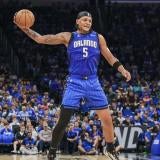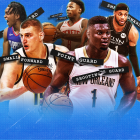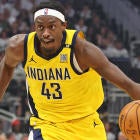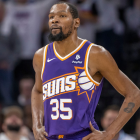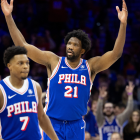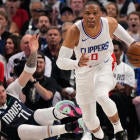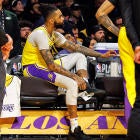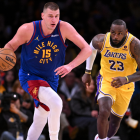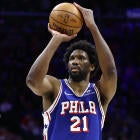
Zion Williamson had played 70 NBA games before the New Orleans Pelicans' coaching staff decided it was time. He had already evolved into a perimeter playmaker, even initiating the offense in certain situations. On April 9, though, with Lonzo Ball out with a hip injury, Williamson was not just one of the Pelicans' many ballhandlers. He was their 6-foot-7, 284-pound point guard.
Williamson got 95 touches, which is more than all but three players average. The ball was in his hands for 7.7 minutes, which is longer than Chris Paul has it in an average game. He finished with 37 points, a career-high 15 rebounds, a career-high-tying eight assists and a victory over a championship contender. Williamson's primary defender was Ben Simmons, who recently argued he should win Defensive Player of the Year because, when the Brooklyn Nets' Kevin Durant was ruled out against Philadelphia, Simmons' assignment changed from Durant to Kyrie Irving.

CBS Sports HQ Newsletter
Your Ultimate Guide to Every Day in Sports
We bring sports news that matters to your inbox, to help you stay informed and get a winning edge.
Thanks for signing up!
Keep an eye on your inbox.
Sorry!
There was an error processing your subscription.
The NBA mandates that every team submit a signed lineup sheet 30 minutes before each game. The starting five must be in a G-G-F-F-C format. Simmons is 6-foot-11 and has been the Sixers' nominal point guard for the last five years. When they started point guard T.J. McConnell in the 2018 playoffs, they officially listed Simmons as a guard and 6-foot-3 sharpshooter J.J. Redick as a forward.
The Denver Nuggets orbit around this season's MVP frontrunner, Nikola Jokic, who is 6-foot-11 and has the same listed weight as Williamson. Jokic leads the league in touches and passes made and ranks sixth in assists. The back-to-back Most Valuable Player and reigning DPOY is the 6-foot-11 Giannis Antetokounmpo, whom the Milwaukee Bucks used to start at point guard and they now use, occasionally, as a smallball center.
The league has been trending toward positional fluidity for years, and its boundary-breaking superstars are merely more extreme examples of what we've seen before. The 6-foot-9 Magic Johnson ran point for some of the most efficient and exciting teams in NBA history and started at center in the game that clinched the first of his five titles. Seven weeks before he was drafted, LeBron James said he could see flashes of Johnson and 6-foot-7 point guard Penny Hardaway in his own game. There is no precedent for Williamson's blend of power, playmaking, leaping ability and touch around the rim, but he told ESPN that he has studied film of Johnson, Isiah Thomas and Michael Jordan's short-lived point guard experiment.
When Draymond Green and P.J. Tucker closed games at center during the 2018 Western Conference finals, though, "positionless basketball" could still largely be defined as "putting traditional guys in the next position over," as Chris Bosh put it nine years ago. The "positional revolution," according to Nathaniel Friedman, who coined the phrase and founded seminal blog FreeDarko, is about players "being allowed to play their own game and have that dictate their roles, rather than have roles imposed on them by a traditional (or non-traditional) system." This opportunity, however, was almost exclusively afforded to stars. At least until recently.
It is one thing to let Zion be Zion, let Jokic be Jokic or even let Draymond be Draymond. It is another to empower a role player to be something entirely new. If there is a face of today's positional revolution, he is not a spectacularly skilled giant. He stands 6-foot-4, weighs 202 pounds and was picked No. 42 in the 2018 draft.

Bruce Brown's role evolved naturally. Next to some of the best scorers who have ever touched a basketball, Brown had to manufacture buckets by making timely cuts, attacking close-outs and coming up with offensive rebounds. From the beginning, it was nothing like starting at point guard for the Detroit Pistons. It wasn't until James Harden's seventh game with the Nets, though, that Brown became a revolutionary.
"I just realized, I mean, when I was on the floor with K.D., Ky and James, more than likely l have the weakest defender on me," Brown said. "Just trying to get the weakest defender on James or Ky, so they could go to work."
In Atlanta on Jan. 27, the Hawks tried to hide Trae Young on Brown. The first time Brown set a high ball screen for Harden, it led to Timothe Luwawu-Cabarrot missing an open 3-pointer. The second time, Brown got a wide-open layup out of it. The third time, Brown short-rolled into open space, caught a pass from Harden, spun past Young and made a floater over Kevin Huerter. A couple of minutes later, he slipped a screen for Irving and got another uncontested layup. Postgame, Nets coach Steve Nash said Brown "kind of played a center."
In the short roll, playing 4-on-5 like a smaller Draymond, his job is simple: Read the defense and make the right play. Most of the time, it is either a lob, a floater or a kickout for a corner 3.
"That's where the point guard comes out of me," Brown said.
Opposing teams trap Harden, double Durant in the post and send help when any of the headliners drive. Surrounded by stars and floor spacers like Joe Harris, Jeff Green and Landry Shamet, defenders tend to "turn their heads and forget about me," Brown said. He takes advantage of that.
"It's actually crazy," Brown said. "Most of my life, I usually was the one having defenses prepare for me. So now, me just getting wide-open layups under the basket -- like, Golden State, I was getting the easiest layups I've ever had in my life."
After a conversation with Nash, he started setting screens more often, earlier in the shot clock and closer to halfcourt. The higher the screen, the more likely it is that Harden or Irving can get downhill at full speed. Some opponents, like the Sacramento Kings and Los Angeles Clippers, tried putting taller, but slower players on Brown. He didn't mind that, since it was easier to roll past them.
Pistons player development coach Bryston Williams had no idea Brown would be doing all this when he worked with Brown on his floaters and finishes last offseason. Inadvertently, however, he helped turn Brown into a roll man.
"He always chuckles, he laughs at me," Brown said. "He was like, 'Yeah, you needed help there, so you could finish around these big guys.'"

At the beginning of Brown's first two seasons, he received a set of three index cards that labeled him an "elite defender" and "opportunity scorer." This is a staple of coach Dwane Casey, who has been handing out these "role cards" out for decades.
Brown started 56 games on the wing as a rookie and proved capable of guarding lead playmakers, most of them significantly bigger than him. On offense, though, he was mostly invisible, as evidenced by his 11.3 percent usage rate.
"I was hearing, 'Don't shoot above the break -- only corner 3s, no floaters,'" Brown said.
His shooting numbers from that season are ghastly -- sub-40 percent from the field, 25.8 percent from deep -- particularly considering that teams usually left him open on the perimeter. The unmistakable confidence he's displayed in Brooklyn was nowhere to be found.
"I think my first year, I was kind of in my own head," Brown said. "And I was put in a box and I got away from my game. I did everything that didn't want to do out there on the floor. There were games when I definitely got back to how I play: downhill, aggressive. But there were games when I just was, like, scared to play."
A couple weeks into his second season, pressed into starting-PG duty, Brown logged 40 minutes against the Nets, serving as Irving's primary defender and finishing with 22 points, seven assists and seven rebounds. All season, opponents went under when he ran pick-and-roll, and the coaching staff still didn't want him taking non-corner 3s or midrange shots, but he managed to show he was more than a defensive specialist.
"I came back and I was just like, I can't have the same thing happen as my rookie year," Brown said. "I gotta go out there and play and do what I need to do. If I get yelled at, I get yelled at. But at least I'm trying."
In Brooklyn, Brown is not just in a different role. He is in a different basketball universe, where he gets yelled at for not shooting.
"The coaches here give you extreme confidence," Brown said. "They literally tell you to go out there and play your game. If you're open, shoot the ball. Be aggressive. So I just love that. I love hearing that."
Nash called Brown a "solution for us," an "outstanding" defender and a "winner." He didn't know much about Brown when the Nets acquired him, but now believes the Nets are particularly difficult to defend when Brown is finding "soft space on the court" and punishing opponents for being preoccupied with other problems.
"Being on a team where they believe in you, you play a lot more freely, you're not thinking out there, you're just playing your game," Brown said. "And it shows out there."

Terance Mann met Brown before they started high school. A couple of months before they became AAU teammates, Brown told Mann he was going to join the Boston Amateur Basketball Club (BABC). "I was like, 'Yeah, yeah, yeah, whatever, whatever, we don't really need you, we're pretty good right now, but whatever,'" Mann said. Then they were thrown on the court together at a tournament in Boston.
"He's never been to practice with us or anything," Mann said, but they shared a realization as soon as they shared the floor. "I'm like, damn, this dude kind of plays like me."
"We kind of have the same game," Brown said. "We literally do everything out there. There were literally times in AAU games we're fighting over rebounds. Like, we're both having it in our hands and I'm not giving it up and he's not giving it up."
The pair would become best friends ... eventually. "It was hard to get along because we were the same player, same position," Mann said. They were both technically wings, but they were all over the court, running the break, dunking on people and getting triple-doubles. They talked about being overlooked and undervalued, compared to local prospects compiling 40-point games and mixtapes.
"Me and Bruce weren't doing that," Mann said. "We were scoring 18, 10 rebounds, 12 assists night in, night out in AAU. And we were getting no attention for that. And we were on the best AAU team in New England. We barely lost."
Their goal, at first, was to get Division I scholarships. When they made names for themselves and offers started coming in, they started talking about going to the ACC, then the NBA. Brown ended up at the University of Miami. Mann chose Florida State, where teammate leading scorer Dwayne Bacon called him "the Draymond Green on our team."
Like Green, Mann stayed in college for four years. Far from a can't-miss prospect, he only earned an invite to the 2019 NBA Draft Combine after going to the Portsmouth Invitational and the G League Elite Camp. Teams, he heard, were looking at him as a potential 3-and-D guy.
"That's all I gotta do?" Mann said, laughing. "I got so many other things that I can do. My thought was, once they figure out that I'm able to shoot the 3 and play defense, then I could do all my other things and they'll love it."
Mann learned the game from his mother, Daynia La-Force, a longtime coach and former player. "She didn't really try to teach me any position," he said. "She just taught me the game itself, and what each player has to do and why each player is important." Recently, he's been thinking about how that set him apart.

A year after Brown went No. 42, Mann went No. 48. He was not expecting the Clippers to tell him they drafted him to play point guard, which he hadn't done since high school. But he was sure he could do it.
Minutes were scarce as a rookie, outside of his 20 games with the G League's Agua Caliente Clippers. While he played in all of Los Angeles' 13 playoff games, most of those appearances were limited to end-of-quarter defensive possessions. This season he's had much more of an off-ball role, and coach Tyronn Lue doesn't bother with categorizing him.
"Just a basketball player," Lue said. "The 1, 2, 3, 4 at times. Just get him on the floor because he makes things happen."
In Memphis in late February, Clippers star Paul George pulled Mann aside. George told him about the beginning of his career: How he'd struggled with being strictly a defender and spot-up shooter in Indiana, how he used to hesitate instead of letting it fly.
"I don't care if you miss or make it," George told him. "We just need you to take it."
George instructed Mann to keep his head down and his confidence up. If he could play lockdown defense and take open shots, it would be just a matter of time before he could get to his midrange game, attack the rim and do everything else he wants to do.
Over the next month, Mann made 50 percent of his catch-and-shoot 3s. He often defended stars, even with George or Kawhi Leonard next to him. He helped the Clippers as a cutter and put pressure on the rim with his drives, addressing the team's most glaring weakness.
He and Brown were breaking out at the same time. Brown said they knew it was going to happen at some point.
"Both of us, man," Brown said. "People always said I was a combo guard coming out, and he plays 1 through 4. I mean, people just don't know where to put us out on the floor. And now teams are just putting us out on the floor and we'll make plays."
"It's so crazy, man," Mann said. "'We've been together since eighth grade, talking about doing exactly what we're doing now. Back then it was just talking about it, not really thinking it was going to come true."
Lately, Mann has been working on making reads out of the short roll, like Brown. On one possession against the Minnesota Timberwolves in April, he set screens for both Leonard and George before finding an open Patrick Patterson for a corner 3 with a blind, over-the-shoulder pass.
"When I'm rolling, it's like I'm a 4 or a 5," Mann said. "But once I get it in my hand, I'm myself."
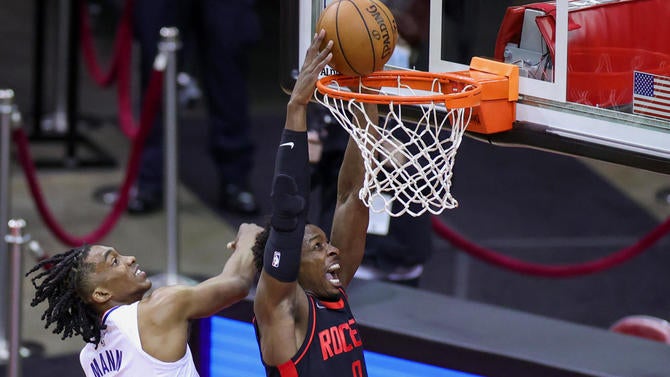
When you invent a new position, people want to name it.
"I heard, like, power guard and stuff," Brown said. "I was like, no, I'm point center."
Mann, meanwhile, does not want to encroach on his best friend's territory.
"I'm good with point forward," Mann said. "I don't know about point center. Bruce is the point center."
Jae'Sean Tate of the Houston Rockets is not picky.
"I like point center," he said initially. Then he amended it to "point forward-center," but even that didn't quite do it for him.
"Point forward-center-guard," Tate said.
Tate is only 6-foot-4, but he's 230 pounds and light on his feet. He laughs when told that the website Cleaning The Glass estimates that he's played about a fifth of his minutes at center, but categorizes him as a forward.
Compared to Brown and Mann, Tate had it made at the beginning of his NBA career. In training camp, Rockets coach Stephen Silas raved about him. He played 37 minutes on opening night and held down a rotation spot after that, primarily because of his defense. Five games into his rookie season, he'd already forced turnovers against Luka Doncic and Damian Lillard one-on-one.
Right away, Tate was setting screens, rolling to the rim and battling on the boards like a big man, while running the floor and handling the ball like a guard. He surprised his own coach, though, a day after the Harden trade. With the Rockets shorthanded in San Antonio, Tate dished 10 assists to go with his 13 points. Postgame, Silas compared Tate to Anthony Mason and said he hadn't realized there was a point forward on the roster.
All of this, however, came at the age of 25. Tate went undrafted in 2018 after four years at Ohio State. He spent the first two years of his pro career in Belgium and Australia.
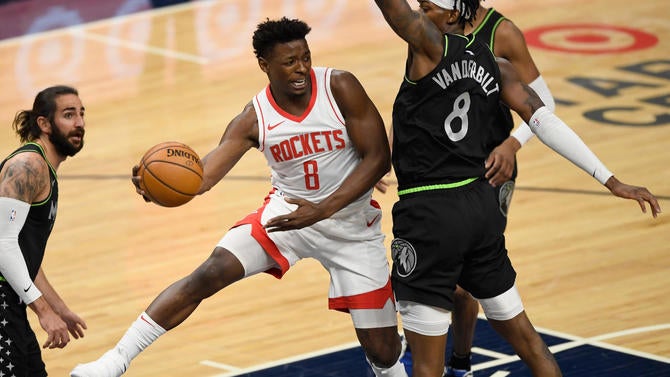
His entire basketball life, Tate has been called undersized. As a senior in high school, SLAM published a story about him trying to overcome the "what position is he?" question. He's quoted saying, "When I'm on the court, there's really no position. Basketball is basketball."
"Every year it's been the same story," Tate said eight years later. "Every single year." He has always played hard as hell and tried to outsmart his opponents. He has always done whatever he could to earn playing time, trust and responsibility from his coach.
"That's basically how it goes," Tate said. "With time, you just continue to prove that, OK, yeah, he's smaller and he's this and that but he's getting the job done."
To sell Sydney Kings ownership on the idea of signing Tate, coach Will Weaver compared him to 6-foot-6 Hall of Fame power forward Charles Barkley. Outlandish as that might sound, Tate was one of the best players in Australia last season. Nobody in the NBL was more efficient in the post.
Questions remained about his jump shot, though, so Houston was able to get him on the cheap: A three-year deal worth $3 million, one of the most team-friendly contracts in the NBA.
Weaver is now an assistant coach on Silas' staff. Early on, the Rockets deployed a lineup of five players ranging in height from 6-3 to 6-6 -- Tate was effectively the center, but everybody was interchangeable. He has started at both forward positions for significant stretches, and the team has come to depend on him more than Silas had ever anticipated. Silas called him "a joy to coach."
"He is [unconventional] because he's undersized, but he's like a 3, 4, and, 'What position is he?'" Silas said. "But he's a basketball player. He's tough, he's smart and he's everything that you want in a young player."
Lately, John Wall has been "helping me become a guy who sets the table," Tate said. The offense is similar to what he was used to in Sydney, where Weaver used to tell Tate he didn't have to look at the coach every time he made a mistake.
"You know, I'm starting to figure that out," Tate said. "I still look over every now and again."
In the fourth quarter of a recent game against the Clippers, Tate ran point. As he dribbled up the floor, Silas asked if he was OK with running a "Horns" set, in which two bigs set high ball screens. Tate answered in the affirmative and executed it to perfection, connecting with Kenyon Martin Jr. on an alley-oop. He followed it up with two more assists on consecutive possessions.
"He was like, 'Damn, I didn't know you could do that,'" Tate said.

In college, Tate watched Green and Tucker force the basketball world to rethink long-held assumptions about the center position. He invoked Draymond's name at the NBA combine, describing himself as a tough guy, an energy guy and a "hybrid," capable of defending guards and bigs, posting up smaller players and beating taller ones off the dribble. It did nothing for his draft stock.
In Belgium, Tate reached out to Tucker, who played five seasons in Europe before finding his NBA niche, via direct message. Tucker said the league would find him if he kept working. Executives hadn't fully learned the lessons that Tucker and Green were teaching, but a couple of years later, Tucker and Tate were teammates in Houston.
"I honestly got lucky that it changed," Tate said. "The trend kind of just started following in my best interests at the right time. I might not even be in the position I am now if we were talking about a traditional -- how it used to be, triangle offense, two bigs, a traditional power forward. But I got blessed enough to be available, still young. I just had to wait until my opportunity came, and it worked out perfect."
Brown said there's no way he would have been given a chance to play this way a few years ago, but called it a "perfect role for me and what I do." Mann said that Green "started that wave" and "set the path" for players like Brown, Tate and himself to follow.
Tate doesn't want kids to get discouraged when they hear they're too small or they don't have a position. There are two sides to that particular coin: If people can't figure out what position you are, it probably means you're versatile. Mann said he is always telling young players, "Whatever your game is, play your game."
In retrospect, it's a wonder that hybrid players like them have fallen through the cracks for this long. There has never been more of an emphasis on skill, speed and switchability, and while there are still some players who fit the 3-and-D prototype, most teams are looking for their supporting cast members to make plays, too. If necessary, some shooting can be sacrificed when just about every team has some sort of stretch big on the roster.
"Being a positionless player, it's kind of scary because you don't know what they're going to do," Mann said. "They got so many tools. They can shoot it, drive it, make the right decision, they kind of have everything in their bag."

Tate will surely make this year's All-Rookie team, which is completely positionless. He, Brown and Mann agree that the same should be true of All-NBA and All-Defense.
"If it's five forwards, then it's five forwards, so be it," Mann said.
This subject became relevant last week when Sports Illustrated's Howard Beck tweeted some notes about eligibility. If you were wondering, Williamson and Antetokounmpo can only be voted in at forward, but Simmons is eligible at both guard and forward and Jokic is eligible at both forward and center.
"The diverse skill of our players is an incredible strength of our league, and that skill has led to many conversations about positionless basketball," NBA spokesman Tim Frank said. "Although we currently determine the All-NBA and All-Defensive Teams by position, we will keep looking at the process and, like everything we do, analyze if we are in the right place."
Antiquated ideas about positions have tangible consequences, but reducing this discussion to the future of the All-NBA and All-Defensive teams does it a disservice. The positional designations on every lineup sheet, every television broadcast and every profile page no longer reflect the way the game is played.
To drive home the point that the Miami Heat were playing "positionless basketball," coach Erik Spoelstra -- the person most responsible for popularizing the term -- stopped using 1-through-5 labels when diagramming plays, opting instead to use players' initials. This was almost a decade ago.
"Usually there is in a sense a 5, but sometimes maybe there's not a 5, there's a roller," Nash said. "There's a point guard, but sometimes maybe it's just an initiator. The lines are definitely blurred nowadays. It's kind of like there's perimeters and then there's a big. You can talk all day about the different nuances or how you want to approach or qualify the positions, but I think it is trending more towards positionless or how the pieces fit together rather than trying to fill out a traditional model."
Silas likes to have a designated point guard responsible for organizing the offense. He thinks it's good to have a center who can set screens, roll and defend opposing bigs. "The other guys," however, "you can kind of mix and match with those positions," he said. "It's not necessarily as important as it was once upon a time, when you had the 2s who were catch-and-shoot guys and the 3s who were Jamal Mashburn, posting up, facing up and shooting midrange shots, and the 4s who were Charles Oakley and Paul Silas, and then they became Matt Bullard and Ryan Anderson."

Friedman coined the term "positional revolution" in October 2006, after the season in which Nash ran point for a team that started Boris Diaw at center and on the eve of the season in which Silas served on Don Nelson's staff with a team that upset the No. 1 seed by playing a bunch of long, athletic, forwards. Around that time, a single blog post could inspire several meditations on better ways to categorize players -- if they must be categorized at all. In the intervening years, scant progress has been made on that front, other than Cleaning The Glass sorting players into five groupings: Point guard, combo guard, wing, forward and big.
While unfortunate, this was never really the point. Today's revolutionaries are dismantling the preconceived notions that prevented them from being highly touted. "Guards" are rolling to the rim like bigs, and "bigs" are facilitating like guards. Oddball players can be their oddball selves.
"What makes players like us important is that we can bring so many different things to the table and you can't really just put us into one thing," Tate said. "Every night, I might have a different task or a different thing that Coach is asking me to do. One possession, you might be guarding a center. The next possession, you might be guarding a point guard. And vice versa on the offensive end. You might be setting screens, rolling and coming off a pick-and-roll the next time or spotting up in the corner. I think that is just what makes this game so beautiful."











